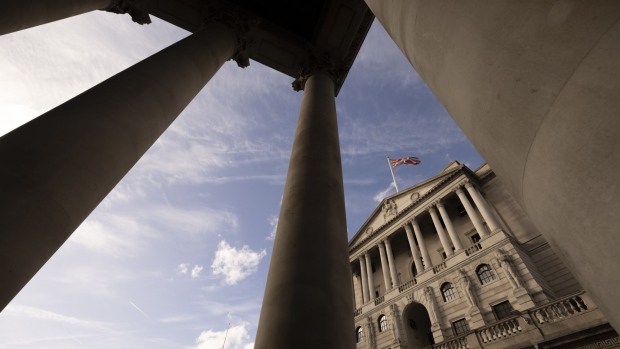Oct 19, 2022
UK Treasury to Transfer £11 Billion to BOE to Cover QE Losses
, Bloomberg News

(Bloomberg) --
The UK Treasury is set to transfer more than £11 billion ($12.4 billion) to the Bank of England this fiscal year to cover projected losses in its bond-buying program, according to a person familiar with the situation.
The capital transfer was detailed in an update to the “Central Government Supply Estimates” published on Tuesday by the Treasury. The new £11.175 billion injection is listed under “assistance to financial institutions -- payment to the Bank of England.”
Parliament is set to debate the payment, which will cover losses for six months, on Monday. The BOE is to begin active sales of its quantitative easing program next month.
The transfer is a key milestone for QE’s journey from government cash cow to liability. The BOE began buying bonds in 2009 and has transferred around £120 billion in profits from the scheme to the Treasury so far.
The sharp rise in interest rates and the steep fall in gilt prices ahead of the BOE’s planned sales have now reversed the flows for the first time. An initial £828 million already been transfered.
In a written ministerial statement, Andrew Griffith, financial secretary to the Treasury, said the government is seeking parliamentary approval for the disbursal this month. Until members of Parliament approve the transfer, an £828 million advance has been made from the “Contingencies Fund.”
The BOE bought £895 billion of government and corporate bonds between 2009 and 2021 to provide economic support after interest rates were cut as low as they could go. The recent fall in bond prices, after interest rates shot up, has left the remaining the £838 billion portfolio of gilts carrying a market loss of about £200 billion.
As the BOE’s purchases are indemnified by the Treasury, any losses will be borne by taxpayer.
BOE officials have repeatedly stressed that the QE program was designed to support the UK economy, thereby protecting jobs and incomes, not to make a profit and should be seen in that context. The BOE declined to comment for this story.
However, the costs of the program are hitting at the worst possible time for Prime Minister Liz Truss’s government, which now needs to find large savings to balance the books in the wake of its disastrous budget last month.
Future Loss
The shortfall stems from the design of the BOE’s bond buying under its quantitative easing program, where the central bank bought bonds in financial markets to stimulate the economy and limit interest rates.
As part of the QE program, an equivalent amount of reserves were created in the form of deposits held by commercial lenders at the bank.
The central bank pays interest on those reserves at the current bank rate. Initially, the cost was more than covered by income earned on government bonds bought by the BOE with the money it created.
That equation has changed now that interest rates have risen to 2.25%, higher than the average coupon income on the gilt portfolio. That’s prompted speculation the government may consider changing the rules of the plan to mitigate the hit. The Treasury denies that tweak is coming.
Pressure to change the payout on reserves may increase along with rising costs of the program. If the BOE’s key rates hit 5% next year, as markets currently expect, interest payments on holdings will be close to £40 billion, according to Bloomberg calculations.
Coupon payments will offset less than half of that, while selling bonds will also likely incur extra losses as prices are currently much lower than they were bought for.
Bloomberg calculations suggest the BOE’s annual loss could top £20 billion as soon as next year. Andrew Hauser, executive director for markets at the BOE, told parliament on Wednesday that it could take 10 years to unwind QE.
A spokesman for the Treasury said “the new chancellor remains very committed to bank independence and has full confidence in it.”
©2022 Bloomberg L.P.







